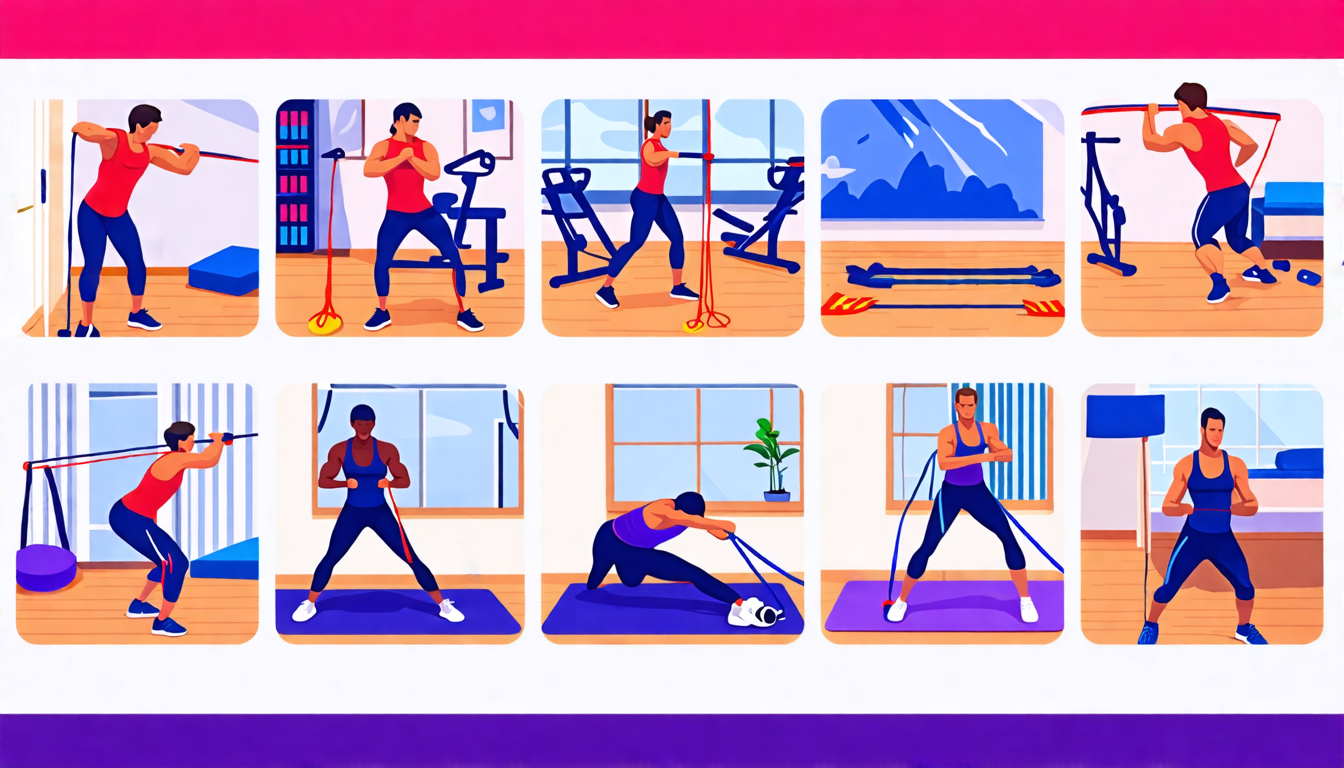Resistance bands are rapidly becoming a staple in home fitness routines, and for good reason. Adding resistance bands to your workout not only elevates the versatility of your exercises but also maximizes their effectiveness. Utilizing resistance bands, you can enhance your muscular strength, improve flexibility, and build stability, all within the comfort of your own home.
By incorporating these elastic tools into various types of workouts, you’ll find that they adapt seamlessly to strength training, cardio, and even rehabilitation exercises. Resistance bands come in different resistance levels, making them suitable for beginners and advanced fitness enthusiasts alike. Whether you’re performing squats, lunges, or even upper body exercises, resistance bands can provide the extra challenge needed to push your limits.
Moreover, their portability allows you to take your workout anywhere, ensuring you never have to miss a session. This introduction will guide you through the benefits of adding resistance bands to your routine and provide practical advice on how to seamlessly integrate them into different types of workouts. Get ready to unlock a new level of fitness versatility and efficiency with the addition of resistance bands.
Benefits of Adding Resistance Bands to Your Workout Routine
Incorporating resistance bands into your workout routine can revolutionize your fitness journey by adding increased versatility and effectiveness to various exercises. These simple yet powerful tools can significantly enhance your muscular strength, flexibility, and stability.
Increased Versatility
Resistance bands are incredibly versatile, allowing you to target multiple muscle groups with a single piece of equipment. Whether you’re working on your upper body, lower body, or core, resistance bands can be adapted to fit your needs. They can be used in a range of exercises including squats, lunges, push-ups, and even more complex movements like deadlifts and shoulder presses. Moreover, resistance bands come in different levels of tension, making it easy to progress and challenge yourself as your strength improves.
Another aspect of versatility is that resistance bands can be used anywhere, making them ideal for home workouts, travel, or even outdoor exercise. Unlike bulky gym machines or heavy free weights, resistance bands are lightweight and portable. This allows you to maintain your fitness routine no matter where you are, ensuring consistency and progression in your training.
Effectiveness in Various Exercises
When it comes to effectiveness, resistance bands stand out by promoting better muscle engagement. Unlike traditional weights that rely solely on gravity, resistance bands provide continuous tension throughout the entire range of motion. This constant tension helps to activate stabilizing muscles and often engages multiple muscle groups simultaneously. Studies have shown that exercises performed with resistance bands can be just as effective as those using free weights, especially for building muscle and increasing strength.
Resistance bands also allow for variable resistance. As the band stretches, the resistance increases, challenging the muscles at different points during the exercise. This can lead to improved muscle growth and strength, as muscles are worked through their full range of motion. The adaptability of resistance bands enables you to modify the intensity of your workouts easily, making them suitable for all fitness levels, from beginners to advanced athletes.
Muscular Strength
Adding resistance bands to your training routine can significantly boost your muscular strength. Because resistance bands offer varying levels of resistance, you can progressively overload your muscles, a key principle in strength training. Over time, as your muscles adapt to the resistance, you can switch to bands with higher tension to continue challenging yourself and gaining strength.
Moreover, resistance bands can add resistance to bodyweight exercises, transforming them into more challenging and effective strength training moves. For instance, adding a resistance band to exercises like push-ups, squats, and lunges can make these standard moves significantly more difficult, leading to greater strength gains.
Enhanced Flexibility
Flexibility is another area where resistance bands excel. They can be used to perform dynamic stretches that help lengthen muscles and improve overall flexibility. Traditional static stretches often don’t provide the same level of muscle engagement as dynamic stretches with resistance bands. By incorporating these bands into your stretching routine, you can target specific muscle groups more effectively and improve your range of motion.
For example, using a band for a hamstring stretch can allow for a deeper stretch while maintaining control, reducing the risk of injury. Similarly, resistance bands can aid in stretching the shoulders, chest, and back, all crucial areas for maintaining overall flexibility and preventing muscle tightness.
Improved Stability
Stability is a critical component of overall fitness, and resistance bands are excellent tools for enhancing this aspect. Exercises performed with resistance bands require you to maintain tension and control, which engages the stabilizing muscles that support your joints and spine. This improved muscle engagement can lead to better coordination and balance.
For instance, incorporating a resistance band into your core exercises can help activate deeper abdominal and lower back muscles, enhancing your core stability. Similarly, using bands during leg or arm exercises can engage the stabilizing muscles around your joints, reducing the risk of injury and improving functional strength.
Furthermore, resistance bands can help with rehabilitation, particularly for those recovering from injuries. They provide a controlled form of resistance that doesn’t put undue strain on injured muscles or joints. This makes them ideal for gentle strengthening exercises aimed at regaining stability and mobility, helping you return to your regular workout routine faster and more safely.
In summary, adding resistance bands to your workout brings a multitude of benefits. The increased versatility and effectiveness they offer can enhance your overall fitness, targeting multiple muscle groups and allowing for a wide range of exercises. By improving your muscular strength, flexibility, and stability, resistance bands can serve as a powerful addition to any fitness regimen. Whether you’re a seasoned athlete or a fitness newbie, resistance bands offer the adaptability and convenience to help you achieve your workout goals.

How to Incorporate Resistance Bands into Different Types of Workouts
Incorporating resistance bands into your workouts can significantly enhance your fitness routine, regardless of whether your focus is on strength training, cardio, or rehabilitation. Here is a step-by-step guide on how to do so effectively:
Strength Training
Resistance bands can complement or replace free weights in your strength training routine. Here are some effective strength training exercises using resistance bands:
1. Squats
Step-by-Step:
- Stand on the band with feet shoulder-width apart.
- Hold the handles at shoulder height with elbows bent.
- Lower into a squat by pushing your hips back and bending your knees, keeping your chest up.
- Rise back to the standing position while keeping tension on the band.
Tips: Ensure your knees do not extend beyond your toes during the squat to avoid injury. Choose a band with enough resistance to challenge your muscles without compromising your form.
2. Bicep Curls
Step-by-Step:
- Stand on the resistance band with feet together or slightly apart.
- Hold the handles with palms facing forward and elbows close to your sides.
- Curl the handles towards your shoulders, squeezing your biceps.
- Slowly lower the handles back to the starting position.
Tips: Avoid swinging your body during the curls; focus on using your biceps to lift the band. Adjust the resistance band’s length to increase or decrease tension as needed.
3. Band Chest Press
Step-by-Step:
- Anchor the band behind you at chest height using a door anchor or a sturdy object.
- Hold the handles with palms facing down and elbows bent at a 90-degree angle.
- Press the handles forward until your arms are fully extended.
- Slowly return to the starting position, keeping tension on the band.
Tips: Maintain a stable stance to prevent losing balance during the press. Adjust the anchor height and band length to alter the resistance level.
Cardio Workouts
Resistance bands can also add an extra layer of intensity to your cardio exercises, making them more challenging and beneficial:
1. Band Jumping Jacks
Step-by-Step:
- Place the resistance band around your ankles.
- Start with feet together and hands by your sides.
- Jump your feet out wide while bringing your hands overhead.
- Jump back to the starting position.
Tips: Ensure the band stays in place around your ankles by choosing one with the right tension. Maintain a steady pace to elevate your heart rate.
2. Lateral Band Walks
Step-by-Step:
- Place the band just above your knees and assume a semi-squat position.
- Step to the right with your right foot, followed by your left foot.
- Continue stepping laterally for the desired number of repetitions.
- Switch directions to work the opposite side.
Tips: Keep your steps small and controlled to maintain band tension and stay in a semi-squat position throughout the exercise to engage your glutes.
Rehabilitation Exercises
Resistance bands are particularly useful for rehabilitation exercises due to their low impact and adjustable resistance. Here are some examples:
1. Shoulder External Rotation
Step-by-Step:
- Anchor the resistance band to a stable object at waist height.
- Stand with your side to the anchor and hold the handle with the outer hand.
- Keep the elbow of the working arm close to your side and rotate your hand outward, away from your body.
- Slowly return to the starting position.
Tips: Perform this exercise slowly and with controlled movements to prevent strain. Adjust the band’s height and resistance to match your comfort level.
2. Clamshells
Step-by-Step:
- Place the band just above your knees and lie on your side with knees bent.
- Keep your feet together and lift the top knee up while keeping your pelvis stable.
- Slowly lower the knee back to the starting position.
- Repeat for the desired number of repetitions and switch sides.
Tips: Avoid rotating your back or hips while performing clamshells. Use a lighter resistance band to start and gradually increase as your strength improves.
By incorporating resistance bands into your workouts, you can enjoy a versatile and effective fitness routine that targets different muscle groups and fitness goals. Remember to choose the appropriate resistance level, maintain proper form, and adjust the band’s position as needed to maximize the benefits of your exercises.
Incorporating resistance bands into your workout routine significantly enhances both its versatility and effectiveness. These compact and affordable tools can target multiple muscle groups, increase strength, improve flexibility, and promote overall stability. Whether you’re a beginner or an advanced athlete, resistance bands offer scalable options to match your fitness level and goals.
When integrating resistance bands into various types of workouts, the possibilities are endless. For strength training, they can intensify standard exercises such as squats, lunges, and chest presses. In cardio workouts, bands can be used to add resistance to moves like high knees and jumping jacks, making these routines more challenging. For those undergoing rehabilitation, resistance bands provide a low-impact way to rebuild muscle strength and joint stability without overstressing injured areas.
By following step-by-step guidance and paying attention to proper form and resistance levels, resistance band exercises can become a seamless part of your fitness journey. From enhancing traditional moves to introducing new ones, resistance bands ensure a well-rounded and effective workout regime, proving that a simple addition can bring substantial benefits. Whether you’re building strength, boosting your cardio, or recovering from an injury, resistance bands add that extra layer of versatility to help you achieve your fitness goals.

